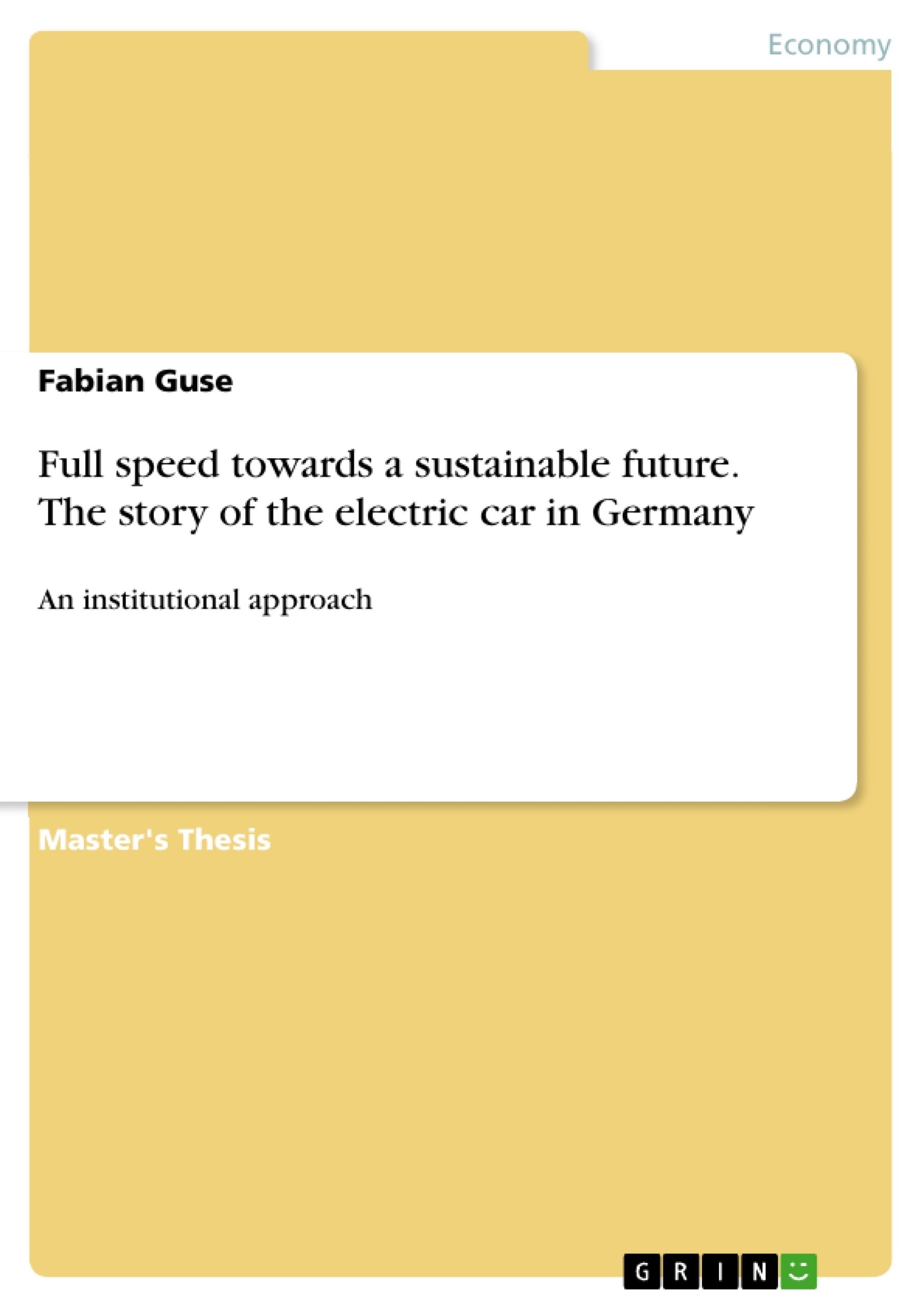“I believe in horses, automobiles are a passing phenomenon”1
(Kaiser Wilhelm II, 1905)
More than 100 years ago when the first motorized vehicles appeared on the streets, Kaiser Wilhelm II was not able to see the potential of this invention and how it would change the world he lived in. Today we are facing the next revolution of transportation technology, elec-tric mobility (e-mobility). In consideration of continuous scarcity of fossil resources and pro-gressive environmental issues caused by increasing amounts of CO2 emissions in our atmos-phere, a rethinking of universally accepted habits is needed. Public and private transportation account for 19% of the overall CO2 emissions in Germany and is therefore one of the largest contributors to climate change and local air pollution (Umweltbundesamt, 2011). This circumstance also shows the great political relevance of this topic as well as the need to make the whole industry more sustainable. A sustainable innovation like the electric car can help to decrease the negative externalities of economic growth and reduce the ecological footprint of a modern-day life. Against this background, the German government proclaims that Germany should be the leading market for e-mobility; aiming to have a diffusion rate of one million electric cars until 2020 (Delhaes, 2008). In order to achieve this, they are dependent on the innovation activities of the German automotive industry. But consumers as well as car manu-factures seem to be skeptical about this novelty, which results in a comparable small diffusion rate of only 7114 electric cars in the end of 2012 (Kraftfahrt-Bundesamt, 2013). For instance, in Denmark the diffusion rate of new electronic cars is 30 times higher than in Germany and even The Netherlands have a rate that is 8 times higher (Masson, 2013). The mentioned diffu-sion rate shows the total number of newly registered electric cars in comparison to the total number of traditional fuel cars within a year. This is curious on a first view as Germany has the largest automotive industry in the world, consisting of firms like BMW, Daimler, Opel and Volkswagen. One would hence expect great interest and a proactive stance from both the firms as well as the government in supporting this innovation.
(...)
Table of Content
1. Introduction
1.1. Research Objectives & Research Question
1.2. Research Contribution
1.3. Structure of the thesis
2. Theoretical Framework
2.1. Sustainable Innovation
2.2. Institutional Theory
()
Inhaltsverzeichnis (Table of Contents)
- Introduction
- Research Objectives & Research Question
- Research Contribution
- Structure of the thesis
- Theoretical Framework
- Sustainable Innovation
- Institutional Theory
- Coercive Pressure
- Mimetic Pressure
- Normative Pressure
- Institutional Change
- Strategic Responses
- Methodology
- Sample Introducing the electric car
- Research Approach & Design
- Data Collection: Sources & Search Terms
- Setting the timeframe
- Database composition
- Analysis
- Results
- A Niche Market (Q1 2003 - Q3 2006)
- The Beginning (Q4 2006 - Q1 2008)
- First Hype (Q2 2008 - Q2 2009)
- Rising Skepticism (Q3 2009 – Q3 2010)
- Second Hype (Q4 2010 – Q4 2011)
- Disenchantment (Q1 2012 – Q4 2012)
Zielsetzung und Themenschwerpunkte (Objectives and Key Themes)
This master's thesis aims to analyze the development of the electric car market in Germany from an institutional perspective. The research utilizes a longitudinal case study approach, focusing on identifying and analyzing key institutional pressures influencing the market's evolution. Key themes explored in the thesis include:- Sustainable innovation and its role in the development of the electric car market.
- The impact of institutional pressures, such as coercive, mimetic, and normative pressures, on market dynamics.
- Strategic responses of companies to institutional pressures, including their influence on the market's trajectory.
- The evolution of the electric car market in Germany over time, considering different phases of development.
- The role of government policy, industry cooperation, and consumer perception in driving the market's growth.
Zusammenfassung der Kapitel (Chapter Summaries)
The introduction of the thesis outlines the research objectives, research question, and the structure of the thesis. The theoretical framework chapter provides definitions and explanations of sustainable innovation, institutional theory, and strategic responses to institutional pressures. The methodology chapter details the research approach, data collection methods, and analysis techniques used in the study. It outlines the sample used, the research design, and the specific data sources and search terms employed. The chapter also discusses the timeframe of the study and the composition of the database. The results chapter presents the findings of the study, analyzing the evolution of the electric car market in Germany through six different phases, starting with a niche market and ending with a period of disenchantment. Each phase is characterized by specific institutional pressures, company actions, and market dynamics.Schlüsselwörter (Keywords)
This study focuses on the development of the electric car market in Germany, utilizing an institutional lens to analyze the role of sustainable innovation, institutional pressures, and strategic responses. The key terms and concepts investigated include sustainable innovation, institutional theory, coercive pressure, mimetic pressure, normative pressure, institutional change, strategic responses, market diffusion, government policy, industry cooperation, and consumer perception.- Citation du texte
- Fabian Guse (Auteur), 2013, Full speed towards a sustainable future. The story of the electric car in Germany, Munich, GRIN Verlag, https://www.grin.com/document/281498



